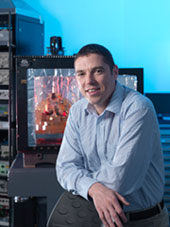Optical Instruments Defining the Evolution of Surface Texture Measurement in Manufacturing
By Professor Richard Leach
Surface texture measurement has a history that began a century ago with the advent of contact-type 2D measurement. Although measurement using optical instruments has been in existence almost as long as contact-type measurement, optical instrument measurement did not become widely used until about 30 years ago. Confocal instruments were introduced about two decades ago, and since then many other optical measurement technologies have come into existence. These developments have occurred alongside a rapid increase in the number of opportunities for optical measurement to be used in manufacturing industry, with further increases predicted in the future.
In the past, contact-type 2D measurement was primarily used in manufacturing industries such as shipbuilding, steelworks and automobile manufacturing. Over the past 20 years, however, surface texture measurement has become important to a number of additional industries including optics, aerospace, medical devices, photovoltaic cells, plastic electronics and electronic paper. These industries differ from those in the past, in that they require the surface texture to affect how the surface functions (flow of liquids, reflection of light, surface tribology, etc.). In addition, the need for greater control over machining processes and functionality has resulted in the widespread use of optical 3D surface texture measurement that enables faster measurement.
ISO Standards Create Improved Optical Reliability
Unlike contact-type measurement, measurement by means of optical instruments does not involve direct contact with surfaces; instead, measurement is based on the reflection of light from the surface. This difference has, until recently, resulted in widely varying results for measurements made by the two methods, with non-contact measurement results at times less accurate than highly reliable contact measurement methods. However, the International Organization for Standardization (ISO) is establishing specification standards which have a defined set of metrological characteristics, which is independent of instrument type. This has allowed for comparisons of the results of measurements, which in turn ensures traceability of both contact and non-contact measurements. As a result, optical instruments have become widely accepted as a means of surface texture measurement.
In addition to these standards, NPL has developed good practice guides for educating industries on how to make meaningful comparisons of different measurement results.
NPL Working to Ensure Measurement Traceability
The National Physical Laboratory (NPL) in the UK is a national measurement institute that endeavours to ensure traceability for all types of measurement. NPL is currently undertaking projects intended to resolve various measurement-related problems, with the ultimate goal of preventing measurement results from being skewed by the type of measurement methods or instruments used. Some of these projects include initiatives to define the optical transfer function for various measurement instruments. Use of the optical transfer function calibrates the response of the instrument to complex surfaces and in some cases allows the instrument to be adjusted, therefore, removing some of the systematic effects that cause optical instruments to differ from contact instruments. NPL hopes that these definitions will eventually be adopted by the ISO.
Laser Scanning Microscopes: Wider Surfaces, Faster Speeds
The distinguishing characteristic of confocal microscopes, such as laser scanning microscopes, is that they boast an extraordinarily broad range of applications. They allow for countless types of measurements for surfaces that can range from very smooth to comparatively rough, and can cover a very wide-ranging area. Laser scanning microscopes have a high dynamic range and can even measure sharp inclines.
Laser scanning microscopes are currently our highest lateral resolution optical instruments with the capability of a large height range measurement and can make fast measurements over small areas. They are expected to make a substantial contribution to the future of surface texture measurement. The effectiveness of laser scanning microscopes will no doubt improve even further once the aforementioned calibration problems are resolved. In particular, due to the predicted increase in demand for in-line measurement in Europe, it is conceivable that industries will soon expect laser scanning microscopes to be capable of measuring larger surfaces at even faster measurement speeds.
 | A principal research scientist with the National Physical Laboratory, Prof. Richard Leach is a Fellow of the Institute of Physics and the Institute of Nanotechnology. Prof. Leach specialises in the development of measurement and characterisation techniques for micro- to nanoscale features, including the measurement of surface topography, micro-coordinate metrology and x-ray tomography. |
Publications by Prof. Richard Leach with Olympus LEXT Laser Scanning Confocal Microscope
- Giusca C L, Leach R K, Fabich M and Gutasuskas T 2011 “Calibration of the areal metological characteristics of scanning confocal microscopes” The 10th International Symposium of measurement technology and intelligent instruments
- Giusca C L, Leach R K, Helary F, Gutauskas and T, Nimishakavi L 2012 “Calibration of the scales of areal surface topography-measuring instruments: part 1. Measurement noise and residual flatness” Meas. Sci. Technol. 23(2012) 035008(10pp)
- Giusca C L, Leach R K and Helary F 2012 “Calibration of the scales of areal surface topography measuring instruments: part 2. Amplification, linearity and squareness” Meas. Sci. Technol. 23(2012) 065005(11pp)
- Giusca, C L, Leach, R K, Helery, F and Gutauskas, T 2013 “Calibration of the geometrical characteristics of areal surface texture measuring instruments.” 13th International Conference on Metrology and Properties of Engineering Surfaces.
- Giusca C L, Evans A A, McDonald D and Leach, R K 2012 “The effect of use duration on surface roughness measurements of stone tool.” 2012 NPL Report ENG 35